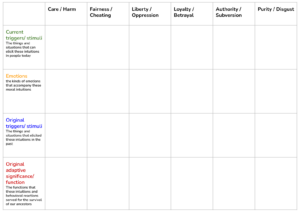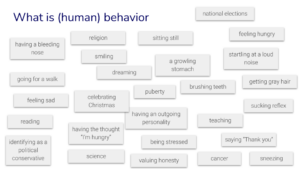Tinbergen's Questions
Proximate mechanisms: What are the immediate triggers and proximate physiological and psychological mechanisms that cause the behavior?
Development: How does a behavior develop over a lifetime?
Evolutionary history: When in the phylogenetic history of the organism did the behavioral trait emerge?
Function or adaptive value of the behavior: What is the function or adaptive value of the behavior that causes an individual to repeat the behavior (or not), or that lead to the behavior becoming more or less common in a population?
“A behavior has just occurred. Why did it happen? Your first category of explanation is going to be a neurological one. What went on in that person’s brain a second before the behavior happened? Now pull out to a slightly larger field of vision, your next category of explanation, a little earlier in time. What sight, sound, or smell in the previous seconds to minutes triggered the nervous system to produce that behavior? On to the next explanatory category. What hormones acted hours to days earlier to change how responsive that individual was to the sensory stimuli that trigger the nervous system to produce the behavior? And by now you’ve increased your field of vision to be thinking about neurobiology and the sensory world of our environment and short-term endocrinology in trying to explain what happened.
And you just keep expanding. What features of the environment in the prior weeks to years changed the structure and function of that person’s brain and thus changed how it responded to those hormones and environmental stimuli? Then you go further back to the childhood of the individual, their fetal environment, then their genetic makeup. And then you increase the view to encompass factors larger than that one individual – how has culture shaped the behavior of people living in that individual’s group? – what ecological factors helped shape that culture – expanding and expanding until considering events umpteen millenia ago and the evolution of that behavior.”
-Robert Sapolsky (2018), p. 6, 7
We can engage content from across the content anchors to explore specific types of causes. Lesson materials across content can engage students in reflecting on these questions of cause and variation in human behaviors, such as:
What if we change the immediate conditions in some way (e.g. of an experiment)? Would the person/individual have behaved differently? Why, or why not?
Does this behavior have some beneficial outcomes for an individual in his/her environment? What might have been this individual’s motivation for behaving like that? (this can be further explored with the help of a Payoff Matrix)
What factors and experiences in the individual’s life might have contribued to the fact that he/she behaved like that?
Do you think humans in all cultures have such a behavior? Why, or why not? How could we find out?
Do you think all mammals (or animals, or living beings) have such a behavior? Why, or why not? How could we find out?
Do you think this behavior might have been beneficial for the survival and reproduction of our ancestors? How and since when? How could we find out?
This presentation summarizes some core developments on the question of causality in evolutionary and behavioral biology over the last decades.
Our take on the organization of Tinbergen’s questions of causality above is a synthesis of these discussions.
Example Teaching Materials that integrate Tinbergen's questions

Causes of our moral intuitions
In this lesson students explore the causes of our moral intuitions with the help of a sorting activity and reflection questions.

What is behavior?
In this lesson students explore the concept of (human) behavior, its causes, and its relation to well-being and sustainable development.



